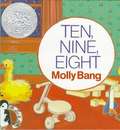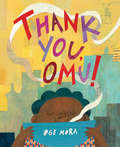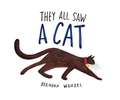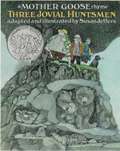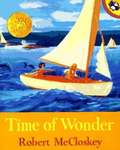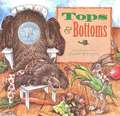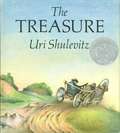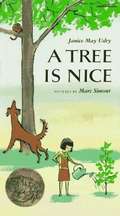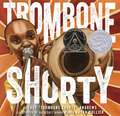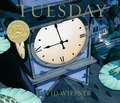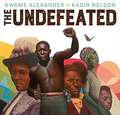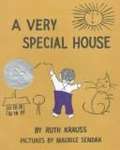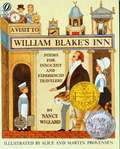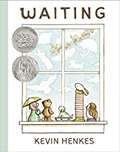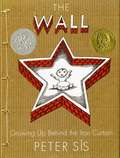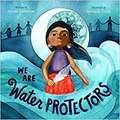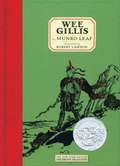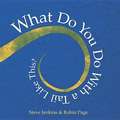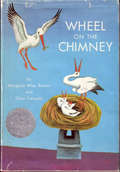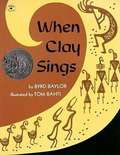Special Collections
Caldecott Award Winners
- Table View
- List View
Ten, Nine, Eight
by Molly BangNine stuffed animals, one sleepy toddler. Numbers from ten to one are part of this lullaby which observes the room of a little girl going to bed.
Winner of the Caldecott Honor
Thank You, Omu!
by Oge MoraIn this remarkable author-illustrator debut that's perfect for fans of Last Stop on Market Street and Extra Yarn as well as for the Thanksgiving season, a generous woman is rewarded by her community.
Everyone in the neighborhood dreams of a taste of Omu's delicious stew! One by one, they follow their noses toward the scrumptious scent. And one by one, Omu offers a portion of her meal. Soon the pot is empty. Has she been so generous that she has nothing left for herself?
Debut author-illustrator Oge Mora brings to life a heartwarming story of sharing and community in colorful cut-paper designs as luscious as Omu's stew, with an extra serving of love. An author's note explains that "Omu" (pronounced AH-moo) means "queen" in the Igbo language of her parents, but growing up, she used it to mean "Grandma." This book was inspired by the strong female role models in Oge Mora's life.
A Caldecott Honors Books
There Was an Old Lady Who Swallowed a Fly
by Simms TabackThere was an old lady who swallowed a fly, a favorite American folk poem, was first heard in the United States in the 1940s. Using an ever-expanding die-cut hole, Simms Taback gives us a rollicking, eye-popping version of the well-loved poem.
They All Saw a Cat
by Brendan WenzelThe cat walked through the world, with its whiskers, ears, and paws...
In this glorious celebration of observation, curiosity, and imagination, Brendan Wenzel shows us the many lives of one cat, and how perspective shapes what we see. When you see a cat, what do you see?
A 2017 Caldecott Honor Book
This Is Not My Hat
by Jon KlassenWINNER OF THE 2013 CALDECOTT MEDAL! From the creator of the #1 New York Times best-selling and award-winning I Want My Hat Back comes a second wry tale. When a tiny fish shoots into view wearing a round blue topper (which happens to fit him perfectly), trouble could be following close behind. So it’s a good thing that enormous fish won’t wake up. And even if he does, it’s not like he’ll ever know what happened. . . . Visual humor swims to the fore as the best-selling Jon Klassen follows his breakout debut with another deadpan-funny tale.
Three Jovial Huntsmen
by Susan JeffersDespite the many animals in the forest, three hunters see only a ship, a house, and a pincushion and find nothing to shoot.
The Three Pigs
by David WiesnerThis Caldecott Medal-winning picture book begins placidly (and familiarly) enough, with three pigs collecting materials and going off to build houses of straw, sticks, and bricks. But the wolf's huffing and puffing blows the first pig right out of the story... and into the realm of pure imagination. The transition signals the start of a freewheeling adventure with characteristic David Wiesner effects--cinematic flow, astonishing shifts of perspective, and sly humor, as well as episodes of flight.
Satisfying both as a story and as an exploration of the nature of story, The Three Pigs takes visual narrative to a new level. Dialogue balloons, text excerpts, and a wide variety of illustration styles guide the reader through a dazzling fantasy universe to the surprising and happy ending.
Time of Wonder
by Robert MccloskeyThe author pictures the beauty of rain, the quiet of night, the attractiveness of foggy mornings, the excitement of sailing, the terror of hurricanes, and the peace of Maine Island.
Tops & Bottoms
by Janet StevensHare solves his family's problems by tricking rich and lazy Bear in this funny, energetic version of an old slave story. With roots in American slave tales,Tops & Bottoms celebrates the trickster tradition of using one's wits to overcome hardship. [This text is listed as an example that meets Common Core Standards in English language arts in grades 2-3 at http://www.corestandards.org.]
Winner of the Caldecott Honor
The Treasure
by Uri ShulevitzA poor man, inspired by a recurring dream, journeys to a far city to look for a treasure, only to be told to go home and find it.
[This text is listed as an example that meets Common Core Standards in English language arts for grades 2-3 at http://www.corestandards.org.]
A Tree Is Nice
by Janice May Udry"Trees are very nice," says Janice May Udry in her first book for children. She goes on to explain that even one tree is nice, if it is the only one you happen to have. Some of the reasons why trees are so good to have around are funny. Some are indisputable facts. But in all of them there is a sense of poetic simplicity and beauty which will be sure to entrance any young child. Whether your child knows one tree or many, he or she will relish the descriptions of the delights to be had in, with, or under a tree. Marc Simont's joyous pictures, half of them in full color, accentuate the child-like charm of the words. And each painting of a tree or trees shows just how very nice they can be.
Trombone Shorty
by Troy "Trombone Shorty" AndrewsA 2016 Caldecott Honor Book and Coretta Scott King (Illustrator) Award Winner Hailing from the Tremé neighborhood in New Orleans, Troy "Trombone Shorty" Andrews got his nickname by wielding a trombone twice as long as he was high. A prodigy, he was leading his own band by age six, and today this Grammy-nominated artist headlines the legendary New Orleans Jazz Fest. Along with esteemed illustrator Bryan Collier, Andrews has created a lively picture book autobiography about how he followed his dream of becoming a musician, despite the odds, until he reached international stardom. Trombone Shorty is a celebration of the rich cultural history of New Orleans and the power of music.
Tuesday
by David WiesnerThe unpredictable events of a particular Tuesday unroll before the reader with the precision and clarity of a silent movie. A Caldecott Medal book.
The Undefeated
by Kwame AlexanderThis book celebrates the black people who have reached the pinnacle of their profession despite their historical sufferings.
A Very Special House
by Ruth KraussContinuing a two-year program to bring back twenty-two Maurice Sendak treasures long out of print, our second season of publication highlights one of the most successful author-illustrator pairings of all time. A pioneer of great children's literature, Ruth Krauss published more than thirty books for children during a career that spanned forty years. Krauss and Sendak collaborated on eight books, and we are delighted to reintroduce four of these gems in brand-new editions, together with a favorite Maurice Sendak picture book.
A Visit to William Blake's Inn
by Nancy WillardNancy Willard was inspired by William Blake's verbal and visual imagery as a child. She has now produced a book of poems that are not "in the style of" but more of an homage to Blake's poetry. The organizing principle is that Blake runs and inn and it is staffed and patronized by a variety of fanciful creatures and people. The rhyme schemes and words are mostly simple enough for children. The allusions and imagery extend the interest to older readers.
Newbery Medal Winner
Waiting
by Kevin HenkesWhat are you waiting for? An owl, a puppy, a bear, a rabbit, and a pig—all toys arranged on a child’s windowsill—wait for marvelous things to happen in this irresistible picture book by the New York Times–bestselling and Caldecott Medalist Kevin Henkes. Five friends sit happily on a windowsill, waiting for something amazing to happen. The owl is waiting for the moon. The pig is waiting for the rain. The bear is waiting for the wind. The puppy is waiting for the snow. And the rabbit is just looking out the window because he likes to wait! What will happen? Will patience win in the end? Or someday will the friends stop waiting and do something unexpected? Waiting is a big part of childhood—waiting in line, waiting to grow up, waiting for something special to happen—but in this book, a child sets the stage and pulls the strings. Timeless, beautiful, and deeply heartfelt, this picture book about imaginative play, the seasons, friendship, and surprises marks a new pinnacle in Caldecott Medalist Kevin Henkes’s extraordinary career. “The short sentences of the text flow with the precision one would expect from a master picture-book creator like Henkes. Little ones, to whom each experience is new, will know what it’s like to dream and wait.”—ALA Booklist
The Wall
by Peter SísThrough journals, maps, and dreamscapes, Peter Sís shows what life was like for a child who loved to draw, proudly wore the red scarf of a Young Pioneer, stood guard at the giant statue of Stalin, and believed whatever he was told to believe. But adolescence brought questions. Cracks began to appear in the Iron Curtain, and news from the West slowly filtered into the country. Sís learned about beat poetry, rock 'n' roll, blue jeans, and Coca-Cola. He let his hair grow long, secretly read banned books, and joined a rock band. Then came the Prague Spring of 1968, and for a teenager who wanted to see the world and meet the Beatles, this was a magical time. It was short-lived, however, brought to a sudden and brutal end by the Soviet-led invasion. But this brief flowering had provided a glimpse of new possibilities- creativity could be discouraged but not easily killed. By joining memory and history, Sís takes us on his journey: from infant with paintbrush in hand to young man borne aloft by the wings of his art.
Winner of the Sibert Medal
Watercress
by Jason Chin and Andrea WangCaldecott Medal Winner, Newbery Honor Book, APALA Award Winner
A story about the power of sharing memories—including the painful ones—and the way our heritage stays with and shapes us, even when we don’t see it.
While driving through Ohio in an old Pontiac, a young girl's Chinese immigrant parents spot watercress growing wild in a ditch by the side of the road. They stop the car, grabbing rusty scissors and an old paper bag, and the whole family wades into the mud to gather as much as they can. At first, she's embarrassed. Why can't her family just get food from the grocery store, like everyone else? But when her mother shares a bittersweet story of her family history in China, the girl learns to appreciate the fresh food they foraged—and the memories left behind in pursuit of a new life.
Together, they make a new memory of watercress.
Author Andrea Wang calls this moving, autobiographical story “both an apology and a love letter to my parents.” It’s a bittersweet, delicate look at how sharing the difficult parts of our histories can create powerful new moments of family history, and help connect us to our roots. Jason Chin’s illustrations move between China and the American Midwest and were created with a mixture of traditional Chinese brushes and western media. The dreamy, nostalgic color palette brings this beautiful story to life. An endnote from the author describes her personal connection to the story, and an illustrator’s note touches on both the process of the painting, and the emotional meaning brought to the work.
We Are Water Protectors
by Carole LindstromInspired by the many Indigenous-led movements across North America, We Are Water Protectors issues an urgent rallying cry to safeguard the Earth’s water from harm and corruption―a bold and lyrical picture book written by Carole Lindstrom and vibrantly illustrated by Michaela Goade. Water is the first medicine. It affects and connects us all . . . When a black snake threatens to destroy the Earth And poison her people’s water, one young water protector Takes a stand to defend Earth’s most sacred resource.
Wee Gillis
by Robert Lawson and Munro LeafA Caldecott Honor Book by the creators of the beloved Story of Ferdinand; Wee Gillis lives in Scotland. He is an orphan, and he spends half of each year with his mother's people in the lowlands, while the other half finds him in the highlands with his father's kin. Both sides of Gillis's family are eager for him to settle down and adopt their ways. In the lowlands, he is taught to herd cattle, learning how to call them to him in even the heaviest of evening fogs. In the rocky highlands, he stalks stags from outcrop to outcrop, holding his breath so as not to make a sound. Wee Gillis is a quick study, and he soon picks up what his elders can teach him. And yet he is unprepared when the day comes for him to decide, once and for all, whether it will be the lowlands or the highlands that he will call his home. Robert Lawson and Munro Leaf's classic picture book is a tribute to the powers of the imagination...
What Do You Do With a Tail Like This?
by Steve JenkinsA nose for digging? Ears for seeing? Eyes that squirt blood? Explore the many amazing things animals can do with their ears, eyes, mouths, noses, feet, and tails in this beautifully illustrated interactive guessing book by Steve Jenkins and Robin Page.
Winner of the Caldecott Honor
What Do You Say, Dear?
by Sesyle JoslinA handbook of etiquette for young ladies and gentlemen to be used as a guide for everyday social behavior. For very small children.
Wheel on the Chimney
by Margaret Wise BrownA story about storks and their home on the wheel of a chimney.
When Clay Sings
by Byrd BaylorBased on the original pottery of the ancient Anasazi, Mogollon, Hohokam and Mimbres cultures, the writer imagines the reasons for the making of the pottery and its creation.
A beautifully-illustrated prose poem for preschool through grade 3 and older readers. These few words convey much about the role of pottery in the Southwestern Native-American culture.
Winner of the Caldecott Honor
